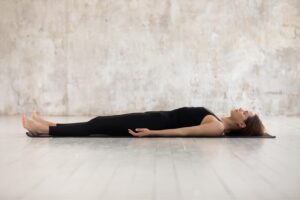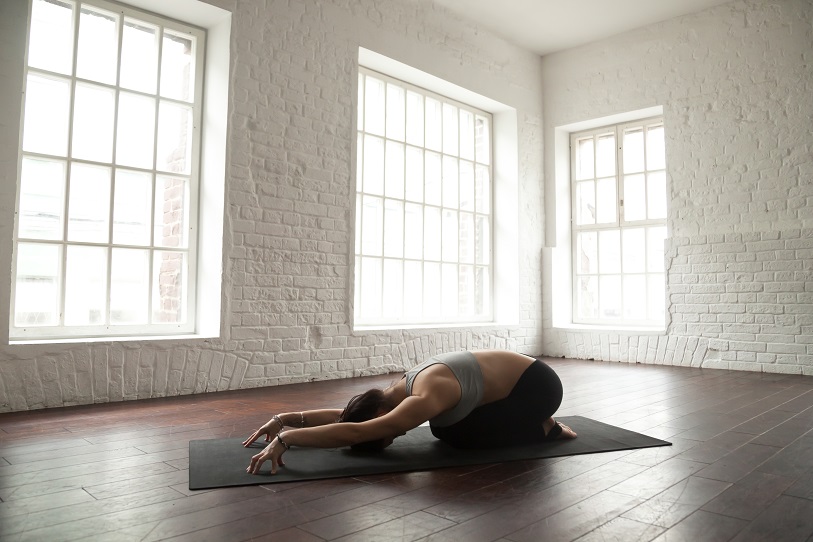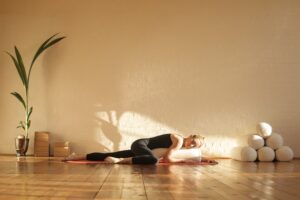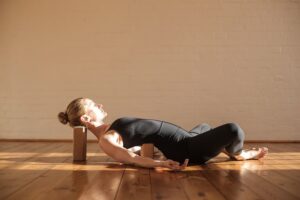Restorative Yoga For Beginners At Home:
Modern life is fast and exhausting. For many, this has become the new norm. it’s become imperative we identify things in our own lives that may help us find relief from time to time. For many, yoga can be that relief. Specifically, restorative yoga poses, even for complete beginners, can be a gentle way of introducing yoga into your daily life. One of the great aspects of restorative yoga, is it’s flexibility when it comes to location to practice. Here, we discuss restorative yoga for beginners at home.

What is Restorative Yoga?
Restorative yoga is a soothing and therapeutic style of yoga that is accessible to people of all ages and fitness levels. It is particularly beneficial for those seeking relaxation, stress relief, and gentle stretching. The essence of restorative yoga lies in its approach, which emphasizes complete surrender and relaxation in each pose or sequence.
This form of yoga is an excellent starting point for beginners. It introduces them to yoga in a nurturing and non-intimidating way. Restorative yoga is characterized by its adaptability, making it suitable for:
- Seniors, providing a gentle way to maintain flexibility and reduce stress.
- Individuals at any fitness level, as it focuses on relaxation and healing rather than physical exertion.
- Those in recovery from injuries or illness, with practices that can be customized to accommodate specific needs and limitations.
Related Article: Yoga for Seniors: Begin With A Gentle & Kind Approach, See Big Results!
Restorative yoga’s emphasis on relaxation and mindful breathing makes it a holistic practice, nurturing both the body and mind.

The use of yoga props can be used to distinguish this form of yoga. Oftentimes, used to support the body. Props include; blankets, yoga mats, pillows, straps, blocks, chairs, and even walls. Consequently, their use can help reduce the action of a muscle in a specified pose. These common items may already be available in your home.
Related Article: Restorative Yoga with Bolsters or Blocks, Along with Some Beginner Poses
Can You Practice Restorative Yoga at Home?
Practicing restorative yoga at home is not only possible but can be a deeply rewarding experience, even during challenging times like a pandemic. To create an effective home practice, consider the following tips:
- Choose a Quiet Space: Select an area in your home where distractions are minimal. A peaceful environment is key to maintaining focus and relaxation during your practice.
- Ensure Comfort and Familiarity: Your practice space should feel comfortable and inviting. Familiar surroundings can help in creating a calming atmosphere that enhances your yoga experience.
- Ample Space for Asanas: Make sure the chosen area is spacious enough to perform various asanas without constraints. Having enough room to move freely is essential for a fluid and comfortable practice.

While it’s not necessary to have a yoga mat to practice restorative yoga at home, it may be more comfortable then a towel or laying on carpet. As we’ve discussed in a recent post on “The Best Way To Meditate at Home“, we emphasize making the space feel welcoming and calming. Consequently, this helps get into a more relaxed state of mind. Placing objects, images, or items that bring about a sense of comfort, is a way to create the right preconditions for achieving harmony and peace.
Practicing restorative yoga at home comes with several advantages that enhance the overall experience:
- Flexible Timing: One of the biggest perks is the freedom to practice at any time that suits your schedule. Whether it’s early morning, during a break in your day, or in the evening, you decide when to unroll your yoga mat.
- Personalized Schedule: You have the autonomy to create a yoga routine that aligns with your daily life. This means you can adapt your practice to fit into your personal and professional commitments without the constraints of a fixed class schedule.
- Choice of Poses and Sequences: At home, you can tailor your practice to your needs and preferences. Whether you want to focus on specific poses for relaxation or a sequence that addresses particular areas of stress or stiffness, the choice is yours.
- Duration of Practice: Another significant advantage is the ability to determine how long your practice lasts. Some days you might opt for a longer session, while on others, a shorter practice might suit your mood and energy levels better. This flexibility allows your yoga practice to evolve with your daily needs.
As beforementioned, yoga is flexible, allowing yogi’s to practice any time of the day. We’ve found for ourselves, practicing restorative yoga at night has been beneficial to help calm our mind and prepare our body for a more restful sleep.
Restorative Yoga Poses For Beginners

Restorative yoga is particularly appealing for beginner yogis due to its simplicity and focus on deep relaxation. This style of yoga doesn’t require mastering a wide range of poses or following complex sequences. Instead, it emphasizes the quality and depth of a few key poses, offering numerous benefits even for those new to the practice.
Emphasizing Depth Over Quantity
- Extended Pose Duration: In restorative yoga, the emphasis is on staying in poses for extended periods. This approach allows for a deeper relaxation and a more profound connection with the body and breath, as opposed to trying to fit in as many poses as possible within a session.
- Maximizing Each Pose: The goal is to maximize the benefits of each pose, fully experiencing and embracing the relaxation and rejuvenation it offers. This mindful approach to each asana encourages a deeper understanding of the body-mind connection.
Progressing in Restorative Yoga
- Accessible Poses: While some yoga poses can appear intimidating, restorative yoga offers accessible options that can be adapted to any level of ability. This makes it an ideal starting point for those new to yoga.
- Physical and Mental Balance: As you progress in your restorative yoga practice, you’ll find that the poses become more comfortable and beneficial, both physically and mentally. You may naturally find yourself extending the duration in each asana as your body adapts and your mind becomes more attuned to the practice.
- Increasing Time in Poses: With time and practice, increasing the duration spent in each pose can enhance the restorative effects, further deepening your sense of relaxation and inner peace.
Restorative yoga, therefore, is an excellent choice for beginners, offering a gentle introduction to yoga that focuses on the restorative and healing aspects of the practice. It allows practitioners to grow at their own pace, gradually building their comfort and proficiency in each pose.

Many yoga poses, (particularly restorative yoga asanas), can be simplified and tailored for age, and abilities. As you progress, you’ll find your strength, and flexibility levels increase. You’ll intimately learn your bodies capabilities, imperfections and what areas may need more work then others. You’ll learn to embrace those small imperfections and tensions that you feel in specific areas, like your pelvis, hips, neck, and shoulders.
Related Article: All About Restorative Yoga: Postures & Sequences
Simple and Effective Restorative Yoga Poses for Beginners
Restorative yoga offers a variety of simple yet profoundly effective poses that are perfect for beginners. These poses are designed to promote relaxation, ease tension, and help newcomers ease into the practice. Here are some beginner-friendly restorative yoga poses:
- Supported Fish Pose (Matsyasana): This pose opens up the chest and lungs, improving respiratory function. It’s excellent for counteracting the slouching that often comes with sitting at a desk.
- Child’s Pose (Balasana): A grounding pose, Balasana is ideal for relaxation and stress relief. It gently stretches the back and hips, helping to release tension.
- Legs Up the Wall (Viparita Karani): This inversion is wonderful for relaxation and can help with reducing lower back pain. It’s also known for improving circulation and soothing tired legs.
- Reclining Bound Angle Pose (Supta Baddha Konasana): This pose helps in opening the hips and groin, and is great for relaxation. It’s beneficial for those who spend a lot of time sitting, as it stretches tightened areas.
- Supported Bridge Pose (Setu Bandha Sarvangasana): A gentle backbend that helps to stretch the front of the body and strengthen the back. This pose can also aid in improving digestion and reducing anxiety.
- Supine Spinal Twist (Jathara Parivartanasana): This twisting pose is excellent for releasing tension in the spine. It’s also great for aiding digestion and helping to calm the nervous system.
These poses are not only accessible for beginners but also deeply restorative, making them perfect for a calming and rejuvenating yoga practice.
Restorative yoga, with its seemingly simple poses, offers profound benefits for both physical and mental well-being. The effectiveness of these poses lies not in their complexity but in their ability to deeply engage and relax the body and mind.
Emphasis on Relaxation and Mindful Engagement
- Gentle on the Body: Restorative yoga emphasizes relaxation over exertion. The poses are designed to be gentle, allowing you to stretch within your body’s limits without pain.
- Listening to Your Body: A key aspect of this practice is tuning into your body’s needs and capabilities, stretching as deeply as it comfortably allows.
- Gradual Deepening of Stretch: Over time, as you achieve relaxation in these poses, your body naturally begins to allow for deeper stretching. This progression happens comfortably and without strain.
Comprehensive Physical Benefits
Restorative yoga provides a range of physical benefits that contribute to overall health and vitality:
- Strengthens the Body: While the movements are gentle, they effectively strengthen various muscle groups.
- Increases Flexibility: Regular practice gently stretches and elongates the muscles, enhancing flexibility.
- Stimulates Blood Circulation: These poses help in improving blood flow throughout the body, vital for good health.
- Enhances Oxygenation: The focused breathing in restorative yoga increases oxygen intake, benefiting the entire body.
- Speeds Up Recovery: Particularly beneficial for those recovering from injuries, these poses aid in a quicker and more comfortable recovery process.
- Relieves Stress: The calming nature of restorative yoga poses significantly reduces stress levels.
- Boosts the Immune System: By reducing stress and improving circulation, restorative yoga helps in strengthening the immune system.
Restorative yoga stands out for its ability to provide profound relaxation and rejuvenation. Its gentle approach makes it accessible and beneficial for people of all ages and fitness levels, offering a path to improved health and a more balanced state of mind.
In fact, did you know that stress influences the immune response, which can therefore cause alterations to immune cells. Activities such as yoga, meditation, hypnosis and muscle relaxation, have been linked to a reduction in the psychological and physiological effect of stress in diseases such as cancers and HIV infections, according to the International Journal of Yoga, 2008.
Broadly speaking, yoga has many potential benefits for the body. in fact, one meta-analysis completed on 42 different studies in 2017, found that yoga asanas were associated with reduced systolic blood pressure, lower evening cortisol levels, lower resting heart rate, fasting blood glucose, and even lower cholesterol levels.
Celebrated Mental Benefits of Restorative Yoga
Restorative yoga, in addition to its physical advantages, offers a wealth of mental and emotional benefits. These aspects are particularly valuable in our fast-paced, often stressful modern lives. The mental benefits of restorative yoga include:
- Promotes Peaceful Sleep: The relaxation techniques inherent in restorative yoga can significantly improve sleep quality, leading to more peaceful and restful nights.
- Healing Emotional Wounds: The gentle, introspective nature of this practice creates a safe space for emotional healing. It allows practitioners to process and release pent-up emotions, aiding in emotional recovery.
- Reduces Symptoms of Anxiety: By promoting relaxation and calming the mind, restorative yoga can effectively reduce anxiety levels, bringing a sense of calm and tranquility.
- Calms the Mind: The practice encourages a state of mental calmness, helping to quiet constant mental chatter and bring about a sense of peace and clarity.
- Enhances Present Moment Awareness: Restorative yoga cultivates mindfulness, encouraging practitioners to stay fully present and engaged in the current moment, thereby enhancing overall awareness.
- Improves Concentration: The focus required in maintaining poses and engaging in mindful breathing helps improve concentration and mental focus.
These mental benefits highlight restorative yoga’s role not just as a physical practice but as a comprehensive approach to mental and emotional well-being. It offers tools to navigate life’s challenges with greater ease and resilience.
Several studies have linked yoga and helping to reduce depression, stress and anxiety symptoms. A 2005 published article suggested potential beneficial effects of yoga on depressive disorders.
A 2013 study out of the Journal of Ayurveda and Integrative Medicine, suggested potential for improvement in overall sleep quality in elderly people and improvement in quality of life with regularly practiced yoga routines.
In addition, multiple other studies link yoga to helping with pain control. For example, this 2013 meta analysis suggesting yoga is a helpful additional therapy for both short term and chronic lower back pain! Studies also suggest broad improvements in many musculoskeletal conditions as they relate to pain and functionality.
Restorative yoga poses, allow an individual the opportunity to truly learn there body. Thus, helping to create mental awareness in relation to different parts of your body. It helps develop a better mind-body connection. It’s a time to focus on breathing. Restorative yoga provides a supportive structure, and therapeutic way of introducing the practice of yoga for beginners. Perhaps for advanced yogis, offering a productive change in routine.
Final Thoughts
Restorative yoga may not be for everyone. However, restorative yoga for beginners at home, is possible. Truly, restorative yoga is different. It enables practitioners to relax, while at the same time, fills us with energy. It can help teach us how to listen to our bodies. Thus, improving how we take care of our needs. In the process, restoring a sense of security, courage, and control.
Remember to be open and curious, to play and experiment, and to enjoy the countless benefits that restorative yoga will bring you.
References:
- https://pubmed.ncbi.nlm.nih.gov/28963884/
- https://pubmed.ncbi.nlm.nih.gov/16185770/
- https://www.ncbi.nlm.nih.gov/pmc/articles/PMC3667430/
- https://pubmed.ncbi.nlm.nih.gov/21829284/
- https://pubmed.ncbi.nlm.nih.gov/23246998/
- https://pubmed.ncbi.nlm.nih.gov/23300142/




